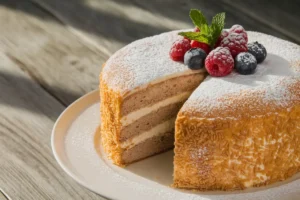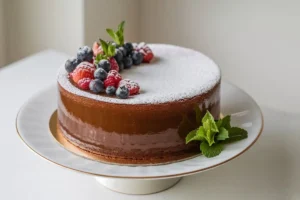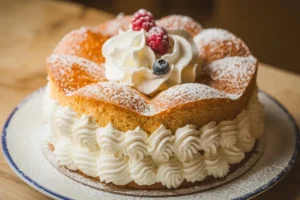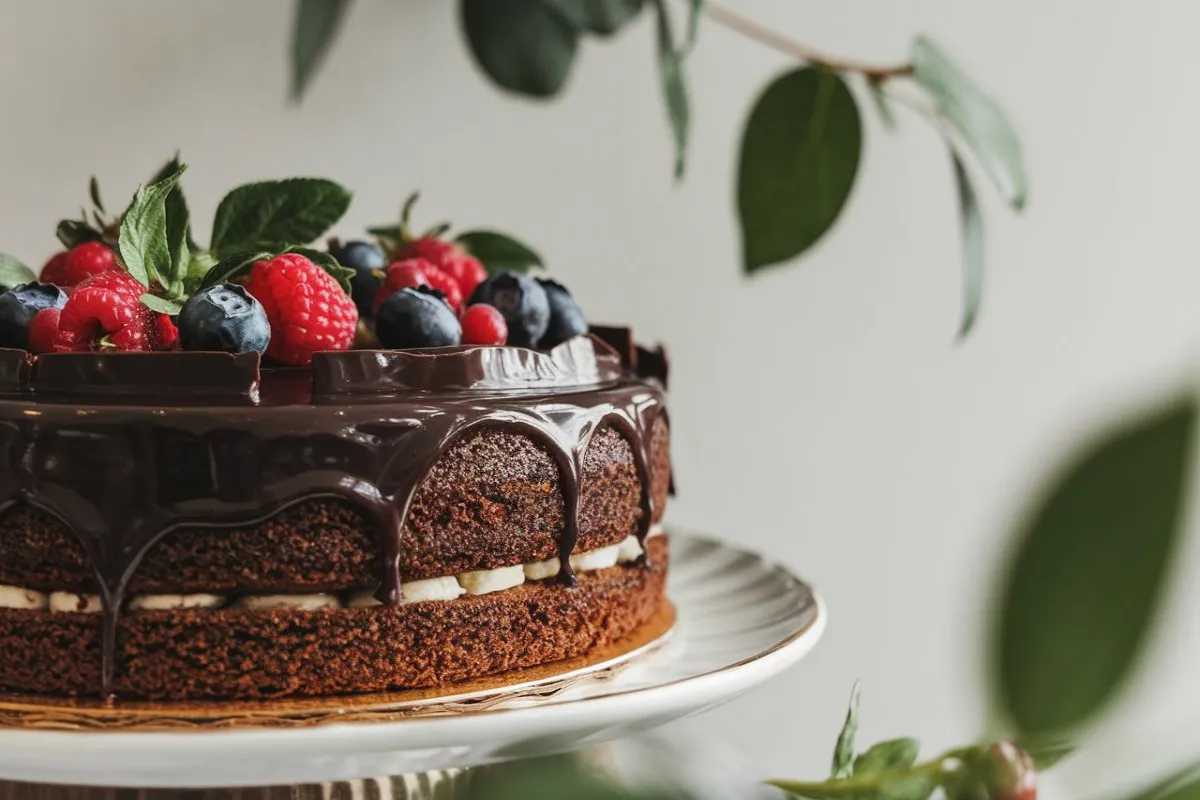Cakes bring joy to people worldwide. They appear in various forms, flavors, and textures. In France, a country famous for its culinary traditions, cakes hold special importance in both everyday life and grand celebrations. But what exactly do the French call cake? This article explores the term gâteau, its cultural significance, and the many types of cakes central to French patisserie.
The Term Gâteau in French
In French, the word for cake is gâteau. This term refers to any baked dessert made with basic ingredients like flour, eggs, butter, and sugar. The word gâteau is a masculine noun in French, so it pairs with masculine articles and adjectives. For example, “a chocolate cake” is “un gâteau au chocolat.”
The French use gâteau to describe a wide variety of cakes, from simple sponge cakes to intricate layered desserts. While gâteau serves as the general term for cake, many specific cakes have their own names, reflecting their unique features. To better understand the different uses of gâteau, you can refer to the Cambridge Dictionary for a detailed explanation.
Interestingly, the French sometimes use the English word “cake” for particular types, like fruitcake or cake au thon (a savory tuna cake). This practice shows how English has influenced French cuisine, where some terms are borrowed and adapted for specific foods.
Different Contexts and Uses of Gâteau
The term gâteau is versatile, covering various cakes. In everyday conversation, people use it to refer to:
- Sponge cakes: These are simple cakes often flavored with vanilla or chocolate.
- Layered cakes: These more complex cakes include multiple layers of sponge, cream, and sometimes fruit.
- Savory cakes: Although less common, savory cakes like cake au thon remain popular.
If you’re curious about the different contexts in which gâteau is used, discussions on platforms like Quora or language blogs can offer valuable insights. These sources often explain the subtleties that aren’t immediately clear from a dictionary.
French culture closely connects with food, and cakes play a crucial role in that relationship. Whether for a casual family gathering or a formal event, cakes always play a part in the occasion. To truly grasp the importance of cakes in French society, one must explore the rich traditions surrounding them.
Cultural Significance of Cakes in France
In France, cakes symbolize more than just desserts—they represent celebration, tradition, and craftsmanship. The French take baking seriously, especially when it comes to cakes. France offers a wide variety of cakes, each with its own history and cultural significance.
One iconic cake is the Fraisier, named after the French word for strawberry, fraise. This cake beautifully shows how the French turn simple ingredients into a work of art. It consists of layers of sponge cake, crème mousseline, and fresh strawberries, making it a staple in French patisserie.
Another legendary cake is the Mille-Feuille, which translates to “a thousand sheets.” This cake features thin layers of puff pastry alternating with rich pastry cream, topped with fondant glaze. The delicate layers and intricate preparation make it a favorite among pastry lovers.
To learn more about traditional French cakes, you can explore the Craftsy article that provides a comprehensive look at various types, including their origins and how they are made.
Exploring Different Types of French Cakes

France offers a broad range of cakes, each with unique flavors and preparation methods. Here’s a closer look at some of the most popular types:
- Mille-Feuille: Also known as Napoleon in some countries, this cake is famous for its layers of puff pastry and pastry cream.
- Fraisier: A strawberry cake made with sponge layers, crème mousseline, and fresh strawberries.
- Gâteau Breton: This rich, buttery cake hails from the Brittany region and has a dense texture.
- Opera Cake: A sophisticated dessert made with almond sponge cake soaked in coffee syrup, layered with coffee buttercream, and topped with chocolate ganache.
- Charlotte: A cold dessert cake made with ladyfingers, filled with fruit puree or custard, and often decorated with fresh fruit.
- Tarte Tatin: A caramelized upside-down apple tart that resembles a cake due to its presentation.
- Clafoutis: A baked dessert with a flan-like batter, traditionally made with black cherries, though other fruits can be used.
Each of these cakes showcases a different aspect of French culinary tradition. From the buttery richness of Gâteau Breton to the refined elegance of Opera Cake, these desserts are more than just food—they are celebrations of the art of baking.
The History of Cakes in France
Cakes have a rich and layered history in France. Initially, during medieval times, bakers made cakes that were simple and rustic, using basic ingredients like flour, eggs, and honey. As France became a culinary hub, cakes evolved into more elaborate creations associated with specific regions and celebrations.
During the Renaissance, French patisserie thrived, influenced by the opulence of the French court and the availability of exotic ingredients like sugar and spices. This period introduced many classic cakes still enjoyed today, such as Mille-Feuille and Gâteau Saint-Honoré.
In the 19th and 20th centuries, French patissiers continued to innovate, creating new techniques and recipes that elevated cakes to an art form. This era also saw the rise of professional patisseries, where cakes could be bought for special occasions, making them more accessible to the public.
Modern Adaptations of Gâteau in France
As tastes and culinary trends evolve, so do French cakes. Today, French patisseries are known for their creativity. They often experiment with new flavors, textures, and presentations. Modern interpretations of classic cakes are now as popular as their traditional counterparts.
For instance, you might find a Fraisier with a twist, incorporating exotic fruits or innovative flavors like matcha. Similarly, the Mille-Feuille might feature salted caramel or coffee cream filling, catering to contemporary tastes.
This blend of tradition and innovation is a hallmark of French cuisine. It ensures that cakes remain dynamic and evolving, appealing to new generations of dessert lovers.
The Role of Cakes in French Celebrations
Cakes play a central role in many French celebrations, from birthdays and weddings to national holidays and religious events. Each occasion has its specific type of cake, often steeped in tradition and symbolism.
- Birthday Cakes: The gâteau d’anniversaire is typically a layered cake, often decorated with candles and frosting. Popular flavors include chocolate, vanilla, and fruit.
- Wedding Cakes: French wedding cakes, known as croquembouche, consist of choux pastry balls piled into a cone and bound with caramel threads. The presentation is as important as the taste, symbolizing abundance and joy.
- Epiphany: The Galette des Rois is a cake traditionally eaten on January 6th to celebrate the Epiphany. This puff pastry cake is filled with almond cream and contains a hidden figurine. The person who finds it becomes the king or queen for the day.
These cakes are integral to the rituals and traditions that define French culture. Sharing a cake often brings people together to celebrate important moments in life.
The Art of French Patisserie

The French are renowned for their patisserie, the art of making pastries and cakes. This craft requires skill, precision, and creativity, and French patissiers take great pride in their work. They understand that success in patisserie depends not only on taste but also on appearance and texture.
Making a cake in a French patisserie involves several stages, from preparing the dough to baking, assembling, and decorating. Patissiers use various techniques to achieve the perfect balance of flavors and textures, whether it’s the lightness of a sponge cake, the richness of a buttercream, or the crispness of puff pastry.
Becoming a patissier in France involves rigorous training, often requiring years of apprenticeships and formal education. This dedication ensures that French cakes maintain the highest quality, a standard that has made French patisserie famous worldwide.
People Also Ask: FAQs Section
What do the French call a birthday cake?
The French refer to a birthday cake as gâteau d’anniversaire. This cake is typically a layered sponge cake, decorated with frosting and candles. Common flavors include chocolate, vanilla, and fruit, often personalized to the birthday person’s preferences.
Is gâteau used for biscuits too?
In some cases, yes. The word gâteau can also refer to biscuits, especially in certain regions of France where the term is used more loosely. However, it generally refers to cakes. The confusion arises because in French, small cakes can also be referred to as biscuits, blurring the lines between the two categories.
What are popular French cake flavors?
French cakes come in a variety of flavors, with some of the most popular being:
- Chocolate: Found in many cakes, from simple gâteau au chocolat to the more complex Opera Cake.
- Vanilla: Often used in sponge cakes and creams.
- Almond: A key ingredient in many traditional cakes, such as the Galette des Rois.
- Fruit Flavors: Strawberry, raspberry, lemon, and apricot are commonly used in French cakes.
- Coffee: Frequently used in buttercream and ganache, especially in Opera Cake.
These flavors reflect the French preference for balance and sophistication in their desserts, where sweetness often pairs with richer, deeper notes.
Conclusion and Final Thoughts

Understanding the term gâteau is key to appreciating French culture and cuisine. Cakes in France are not just about desserts; they weave into the fabric of life. From the everyday sponge cake to the elaborate creations in patisseries, gâteau represents a wide range of desserts celebrated for their taste, texture, and presentation.
Cakes in France stand as a testament to the country’s rich culinary history, reflecting centuries of tradition and innovation. They symbolize celebration, mark important life events, and showcase artistic expression. Whether enjoying a slice of Mille-Feuille with a cup of coffee or sharing a gâteau d’anniversaire with loved ones, you are participating in a tradition as old as it is delicious.
By exploring the different types of gâteaux and understanding their cultural significance, we gain a deeper appreciation for French cuisine and the role that cakes play in it. The next time you enjoy a slice of cake, remember the gâteau and the rich history it represents.

